Time To Upgrade: 10 SSDs Between 240 And 256 GB, Rounded Up
Corsair Neutron GTX And Neutron

With so many companies selling SSDs based on similar controller hardware, firmware, and NAND flash, there's more pressure than ever to differentiate. Much of the time, this comes in the form of price-slashing. That's a great way to get us excited about affordable solid-state storage, but decidedly not an effective money-making strategy.
An SSD veteran compared to some of the other companies in today's story, Corsair set out to change the one performance variable it could: the controller. Its new Neutron and Neutron GTX drives utilize a new controller from Link_A_Media called the LM 87800, and are designed to succeed the company's SandForce-based Force drives. We don’t know much about the chip, as much of its logic is still mired in secret sauce. However, we do know the Link_A_Media controller isn't sensitive to the type of data you throw at it, and that it's based on an eight-channel architecture.
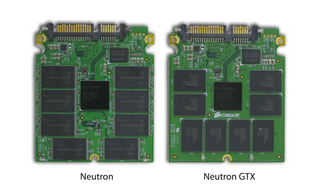
In an effort to promote the best performance possible, Corsair arms its highest-end Neutron GTX drives with 24 nm Toggle-mode DDR NAND from Toshiba, while the Neutron hits a more aggressive price point through the use of 25 nm synchronous ONFi-compatible flash.
Both the Neutron and Neutron GTX come bundled with a mounting bracket. Corsair also supports the two families with five-year warranty coverage, which we really like to see.
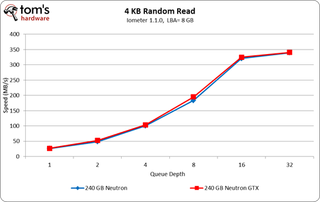
Performance-wise, the Neutron drives are pretty impressive. At a queue depth of one, 4 KB random reads start out at ~25 MB/s (typical of most SSDs that pass through our lab). However, once you scale up to 32 outstanding I/O requests, throughput jumps to nearly 350 MB/s, roughly corresponding to 90 000 IOPS. In random writes, the Neutrons are slower than competing SandForce-based SSDs. However, they also don't take a big hit when you work with incompressible data, either.
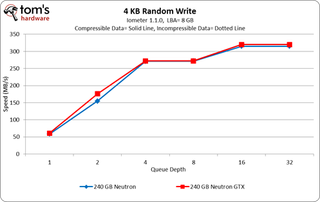
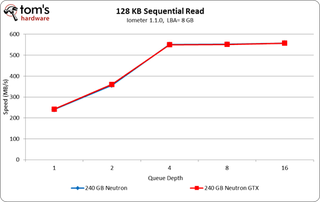
In most cases, the Neutron and Neutron GTX fare very similarly. Our 128 KB sequential write test is the notable exception. Thanks to its faster Toggle-mode memory interface, the Neutron GTX takes a nearly 100 MB/s lead at queue depths higher than two.
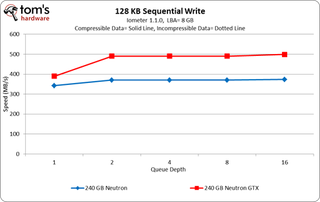
Stay on the Cutting Edge
Join the experts who read Tom's Hardware for the inside track on enthusiast PC tech news — and have for over 25 years. We'll send breaking news and in-depth reviews of CPUs, GPUs, AI, maker hardware and more straight to your inbox.
Current page: Corsair Neutron GTX And Neutron
Prev Page Adata XPG SX900 And Premiere Pro SP900 Next Page Monster Daytona-
mayankleoboy1 get the cheapest, biggest you possibly can. Benchmarks exaggerate the difference between SSD's.Reply -
A Bad Day I agree. Unless if you're buying a glorified USB stick (there is a 128 GB stick) or an SSD with an OC'ed processor, the main factor that consumers should be concerned about is price per gigabyte.Reply -
A Bad Day EDIT: And reliability.Reply
"In order to install a new firmware that significantly boost performance and stability, you must backup all of your data because it will be wiped." -
Tanquen Yea, it’s getting a little out of hand. For 90% of the things 90% of people do on their PC, 200MBs+ read and write speeds just don’t mean much. There are too many other bottle necks going on. I messed around with a RAM drive using most of my 64GB of RAM and the read and write speeds are fun to test (4000MBs or so) but games and VMware sessions I launched from the RAM disc saw no noticeable improvement in launch times or anything else. Same goes for my 830 SSD drive. It’s fast but games and software I use for SCADA development just don’t see any real benefit. They are cool if you want to open 10 sessions of MS Word and 15 Internet Explorer and a bunch of other stuff at the same time but if you just open one instance of Excel and use it and the Photo Shop and use it and then a web browser and use it, you’ll never really see the difference. You have to benchmark it or have two PCs setting right next to each other to see that something started or saved a split second faster.Reply
At least with my 64GB of RAM and actually get 64GB of RAM unlike HDs and SSDs.
-
tomfreak unless the sandforce drive is priced a lot cheaper than the similar capacity non-sandforce SDD. I always choose the non-sandforce SSD. 16GB is a big deal in SSD.Reply -
stoogie until theres affordable 512gb ssd's then i wont get 1, my c drive is 360gb~ and i have 11tbReply -
sna TanquenYea, it’s getting a little out of hand. For 90% of the things 90% of people do on their PC, 200MBs+ read and write speeds just don’t mean much. There are too many other bottle necks going on. I messed around with a RAM drive using most of my 64GB of RAM and the read and write speeds are fun to test (4000MBs or so) but games and VMware sessions I launched from the RAM disc saw no noticeable improvement in launch times or anything else. Same goes for my 830 SSD drive. It’s fast but games and software I use for SCADA development just don’t see any real benefit. They are cool if you want to open 10 sessions of MS Word and 15 Internet Explorer and a bunch of other stuff at the same time but if you just open one instance of Excel and use it and the Photo Shop and use it and then a web browser and use it, you’ll never really see the difference. You have to benchmark it or have two PCs setting right next to each other to see that something started or saved a split second faster.At least with my 64GB of RAM and actually get 64GB of RAM unlike HDs and SSDs.Reply
to see the difference you will need to put the system itself on RAM Disk. not only the installed programs.
-
Where are Samsung SSDs ? Especialy model Samsung 830- 256GB which is on sale in Europe for 160-180€. That is best offer, reliable, faster than basic 840. Get some MB with Z77 chipset and you can RAID them with TRIM support. 2x256 for 330€ is so awesome with 1035Mb/s read in RAID 0. I tested it on Gigabyte Z77-UP4 TH, its a shame that there are only 2x6Gbit ports so 1x840 Pro + 2x830 in RAID 0 is impossible on this MB without SATA2 speed loss on remaining SATA ports. This was my scenario for fast gaming /500GB Steam inventory/ : Raptor, later RAID 0 HDDs, later Velociraptor, next 128GB SSD + 1GB Samsung HDD cached by OCZ Synapse 64GB /totaly unreliable/. So I ended up with 1x boot SSD + 2x SSD in RAID 0. Maybe I am little bit offtopic but any ideas how to "live" with increased Steam inventory and keep it fast enough ? Steamover SW is not reliable for me. Thanks for nice article.Reply
-
ojas ReplyWhen Thomas, Don, and Paul prioritize the parts for their quarterly System Builder Marathon configurations (the next of which is coming soon, by the way)
Wait, SBMs are fine, but where oh where went BestConfigs? -
-Fran- I went for a Vertex4 and placed it in my notebook. What a boost. I'd say it also helped improve battery life.Reply
For a Desktop, I don't have a particular use TBH. I have a RAID0 with 2x512GB WD's and it works amazingly good (and fast as well). I'd say, for desktops, SSDs are still not viable because of price, unless you clench your teeth with loading times or such, hahaha.
Cheers!
Most Popular

